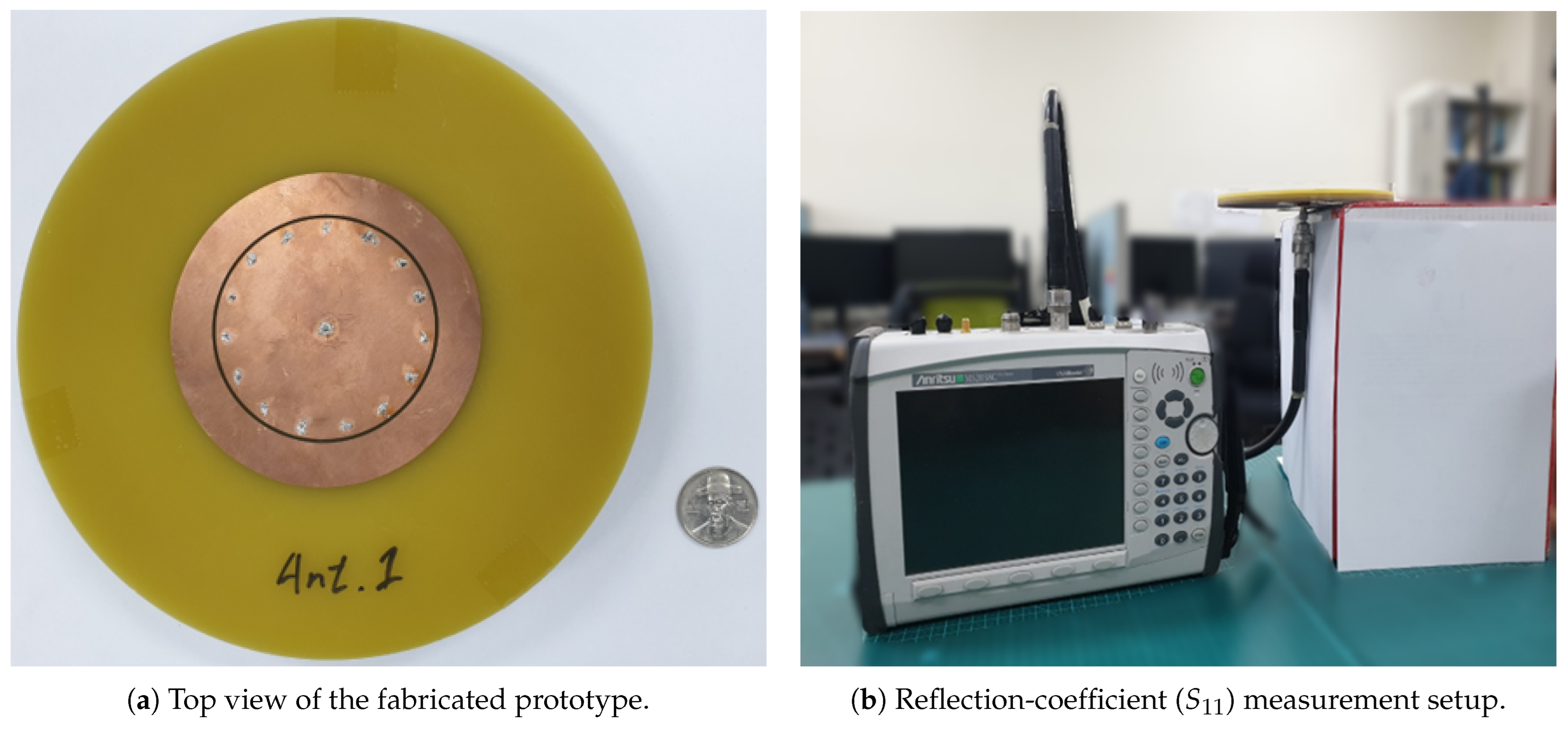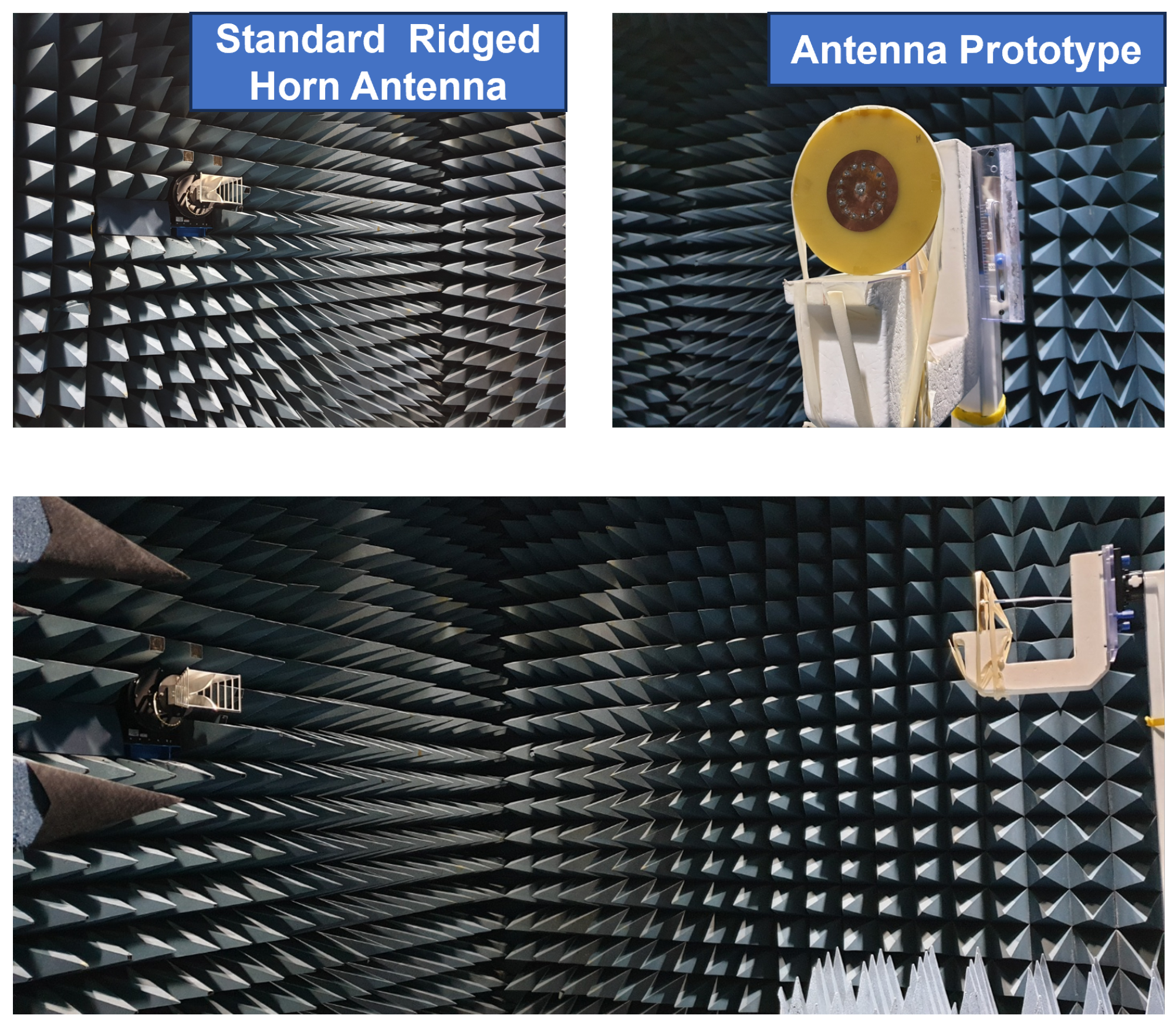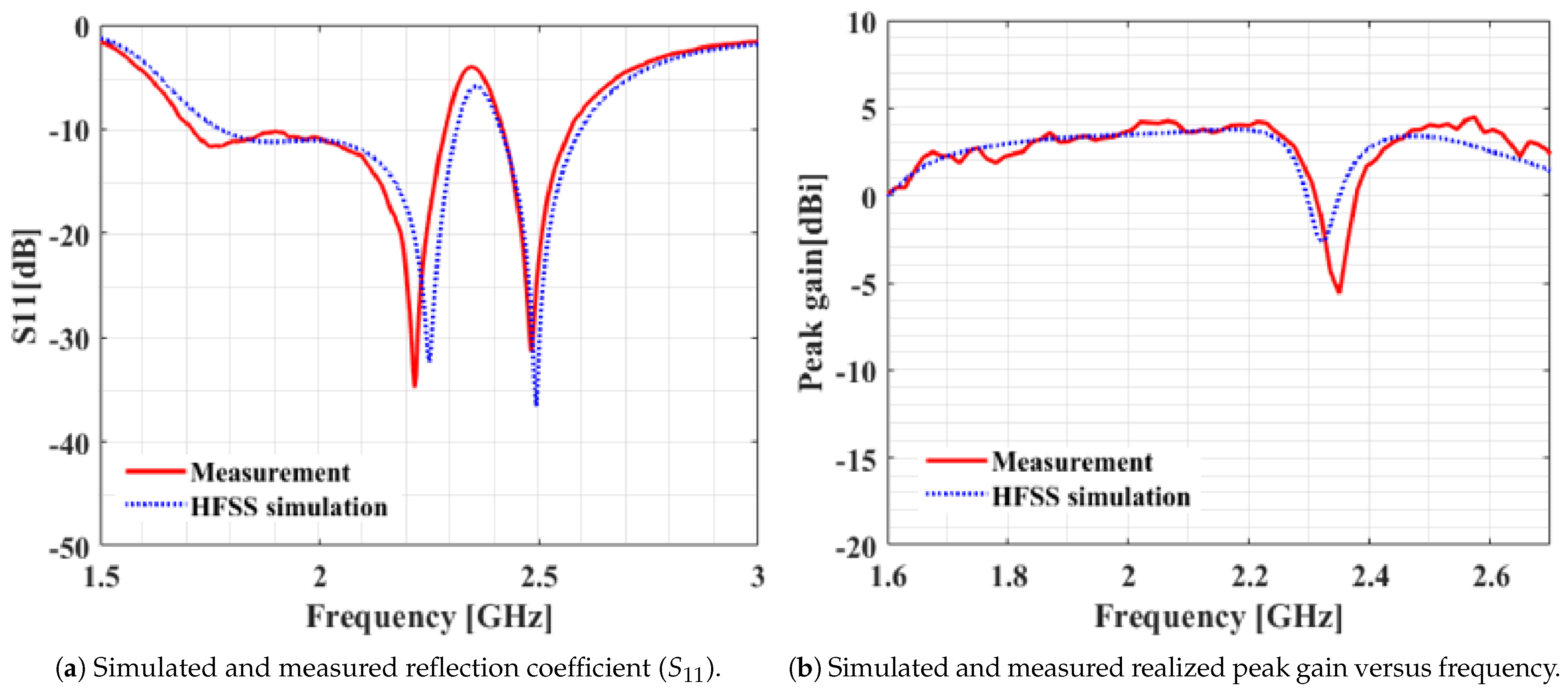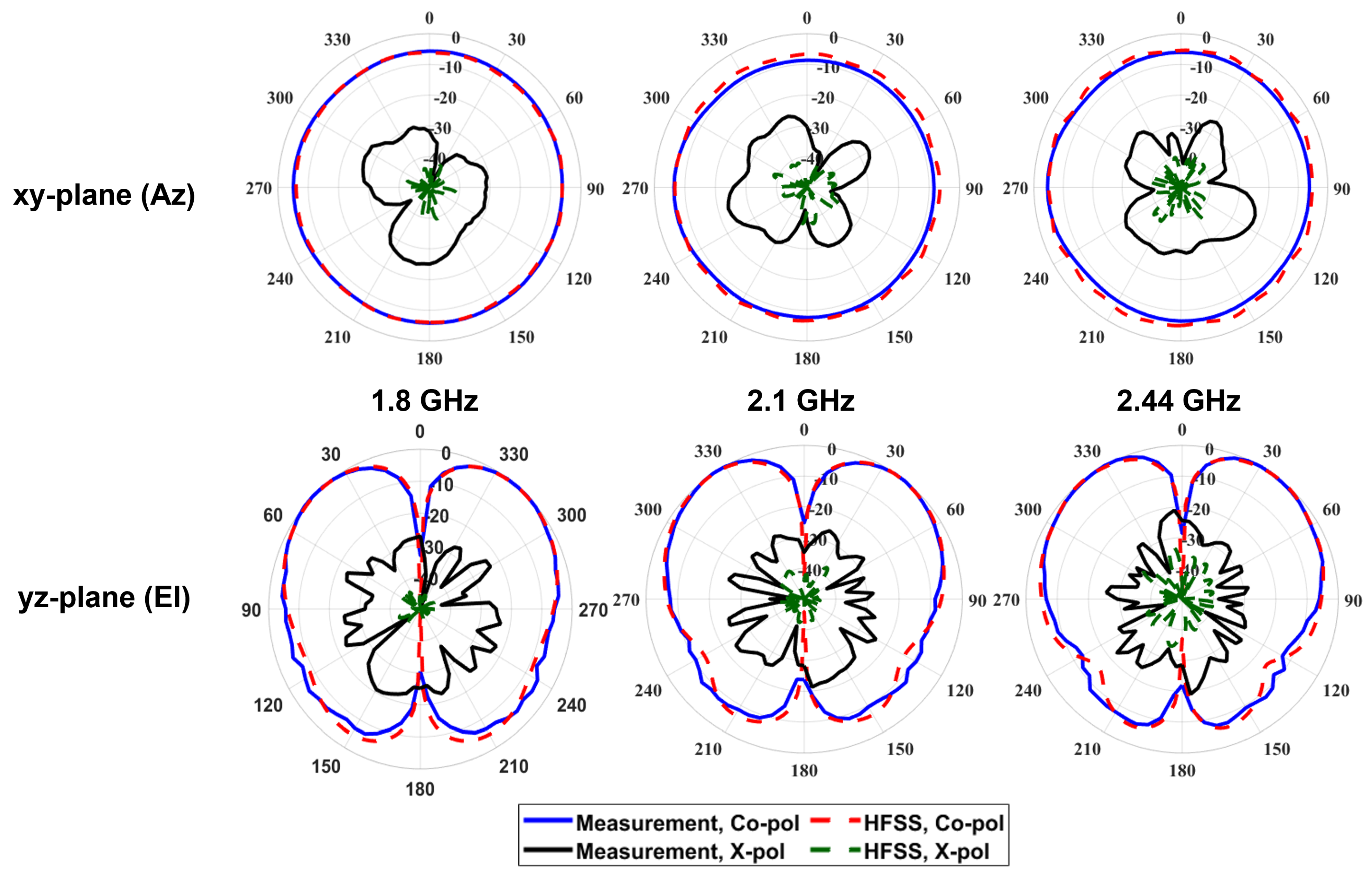Dual-Band Multilayer Patch Antenna for Multiband Internet-of-Vehicles Applications
Abstract
1. Introduction
- A compact multilayer patch antenna is designed for dual-band operation at LTE B1/B3 and WLAN frequencies.
- The antenna achieves 28% and 6.4% measured impedance bandwidths with a low profile of , far shorter than conventional monopoles.
- Integration of shorting vias, a coupled ring, and an embedded parasitic patch enables broadband matching and omnidirectional radiation.
- Two-stage validation—anechoic-chamber measurements and LTE field trials—confirms stable radiation, 4.46 dBi peak gain, and improved signal strength, SNR, and throughput compared with a commercial monopole.
- The antenna offers low-cost FR-4 implementation, robust multiband IoV/V2X performance, and scalability for vehicular communication systems.
2. Antenna Design and Optimization
2.1. Antenna Geometry
2.2. Resonance Behavior and Bandwidth Enhancement
2.3. Coupled Ring Optimization
3. Experimental Validation
4. Field Validation of LTE Performance for IoV
5. Conclusions
Author Contributions
Funding
Data Availability Statement
Acknowledgments
Conflicts of Interest
References
- Hartenstein, H.; Laberteaux, K.P. A Tutorial Survey on Vehicular Ad Hoc Networks. IEEE Commun. Mag. 2008, 46, 164–171. [Google Scholar] [CrossRef]
- Molina-Masegosa, R.; Gozalvez, J. LTE-V for Sidelink 5G V2X Vehicular Communications. IEEE Veh. Technol. Mag. 2017, 12, 30–39. [Google Scholar] [CrossRef]
- Contreras-Castillo, J.; Zeadally, S.; Guerrero-Ibáñez, J.A. Internet of Vehicles: Architecture, Protocols, and Security. IEEE Internet Things J. 2018, 5, 3701–3709. [Google Scholar] [CrossRef]
- Chung, M.-A.; Tseng, K.-C.; Meiy, I.-P. Antennas in the Internet of Vehicles: Application for X-Band and Ku-Band in Low-Earth-Orbiting Satellites. Vehicles 2023, 5, 55–74. [Google Scholar] [CrossRef]
- Khan, S.; Mazhar, T.; Shahzad, T.; Bibi, A.; Ahmad, W.; Khan, M.A.; Saeed, M.M.; Hamam, H. Antenna systems for IoT applications: A review. Discov. Sustain. 2024, 5, 412. [Google Scholar] [CrossRef]
- Delaveaud, C.; Leveque, P.; Jecko, B. New kind of microstrip antenna: The monopolar wire-patch antenna. Electron. Lett. 1994, 30, 1–2. [Google Scholar] [CrossRef]
- Economou, L.; Langley, R.J. Patch antenna equivalent to simple monopole. Electron. Lett. 1997, 33, 727–729. [Google Scholar] [CrossRef]
- Al-Zoubi, A.S.; Yang, F.; Kishk, A.A. A broadband center-fed circular patch–ring antenna with a monopole-like radiation pattern. IEEE Trans. Antennas Propag. 2009, 57, 789–792. [Google Scholar] [CrossRef]
- Liu, J.; Shen, Z.; Gong, Y.; Lin, F. Design and analysis of a low-profile and broadband microstrip monopolar patch antenna. IEEE Trans. Antennas Propag. 2013, 61, 11–18. [Google Scholar] [CrossRef]
- Chen, X.; Dou, H. Wideband patch antenna with shorting vias. Int. J. Antennas Propag. 2022, 2022, 2578409. [Google Scholar] [CrossRef]
- Ha, Y.; Jung, J.-i.; Lee, S.; Pyo, S. Extremely low-profile monopolar microstrip antenna with wide bandwidth. Sensors 2021, 21, 5295. [Google Scholar] [CrossRef] [PubMed]
- La, D.-S.; Zhao, J.-H.; Chen, S.-M.; Zhang, C.-X.; Qu, M.-J.; Guo, J.-W. Dual-band omnidirectional coupled-fed monopolar filtering antenna. Eng. Sci. Tech. Int. J. 2022, 35, 101188. [Google Scholar] [CrossRef]
- Yu, S.; Cheng, F.; Gu, C.; Zhang, B.; Huang, K. Substrate integrated waveguide omnidirectional filtering antenna with a controllable radiation null for 5.8 GHz WiFi application. Int. J. RF Microw. Comput.-Aided Eng. 2022, 32, e23007. [Google Scholar] [CrossRef]
- Huang, J.; Zhu, J.; Li, H.; Ma, D.; Tang, H.; Ge, J.; Zhang, X.-F.; Zhou, L.-H.; Chen, J.-X. Filtering wideband omnidirectional patch antenna with four operation states. AEU Int. J. Electron. Commun. 2024, 177, 155223. [Google Scholar] [CrossRef]
- Xiang, Z.; Wang, Z.; Li, C.; You, R. Design of UWB monopole antenna with ring structure based on characteristic mode theory. Prog. Electromagn. Res. C 2025, 158, 225–234. [Google Scholar]
- Fazal, D.; Khan, Q.U.; Hong, I.-P. Multiband Antenna Design with Enhanced Radiations Using Characteristic Mode Analysis. Sci. Rep. 2023, 13, 17829. [Google Scholar] [CrossRef]
- Li, J.; Huang, J.; He, H.; Wang, Y. An Ultra-Thin Multi-Band Logo Antenna for Internet of Vehicles Applications. Electronics 2024, 13, 2792. [Google Scholar] [CrossRef]
- Lakshmi, M.N.V.K.; Prasad, A.M. Design of high flexible multi-band conformal printed patch antenna for sub-6 GHz 5G-based vehicular communication. Int. J. Electron. 2024, 112, 1494–1515. [Google Scholar] [CrossRef]
- Yahya, M.S.; Soeung, S.; Musa, U.; Samaila, Y.A.; Yunusa, Z.; Hamzah, S.A.B. A compact dual-band antenna for enhanced vehicle-to-vehicle communication. Transp. Res. Procedia 2025, 84, 370–377. [Google Scholar] [CrossRef]
- Kannappan, L.; Palaniswamy, S.K.; Kanagasabai, M.; Rajakani, R.; Sundarsingh, E.F.; Alsath, M.G.N. Quad-port multiservice integrated optically transparent automotive antenna for vehicular classification applications. Sci. Rep. 2023, 13, 17614. [Google Scholar] [CrossRef]
- Keshavarz, R.; Winson, D.; Lipman, J.; Abolhasan, M.; Shariati, N. Dual-band, slant-polarized MIMO antenna set for vehicular communication. In Proceedings of the 2023 17th European Conference on Antennas and Propagation (EuCAP), Florence, Italy, 26–31 March 2023; pp. 1–5. [Google Scholar] [CrossRef]
- Yadav, S.V.; Yadav, M.V.; Yadav, D.; Yadav, R.S.; Kumar, R. Multi-band high-frequency antenna for satellite, automotive radar, and 6G communication. Sci. Rep. 2025, 15, 30400. [Google Scholar] [CrossRef] [PubMed]
- Balanis, C.A. Antenna Theory: Analysis and Design, 4th ed.; Wiley: Hoboken, NJ, USA, 2016. [Google Scholar]
- Pozar, D.M. Microwave Engineering, 4th ed.; Wiley: Hoboken, NJ, USA, 2011. [Google Scholar]
- Hong, J.-S.; Lancaster, M.J. Microstrip Filters for RF/Microwave Applications; Wiley: New York, NY, USA, 2001. [Google Scholar]
- Blanch, S.; Romeu, J.; Corbella, I. Exact representation of antenna system diversity performance from input parameter description. Electron. Lett. 2003, 39, 705–707. [Google Scholar] [CrossRef]
- Sharawi, M.S. Printed MIMO Antenna Engineering; Artech House: Norwood, MA, USA, 2014. [Google Scholar]
- Sultan, A.; Jabeen, S.; Fazal, D.; Khan, Q.U. Dual-band dual-polarized MIMO design for vehicular applications. AEU—Int. J. Electron. Commun. 2023, 170, 154772. [Google Scholar] [CrossRef]
- ETSI TS 136 214 V17.0.0; LTE; Evolved Universal Terrestrial Radio Access (E-UTRA); Physical Layer; Measurements. ETSI 3rd Generation Partnership Project (3GPP): Valbonne-Sophia Antipolis, France, 2022.












| Parameter | Value [mm] | Parameter | Value [mm] |
|---|---|---|---|
| 90 | r | 0.25 | |
| 31 | d | 29 | |
| 35 | a | 32 | |
| 9.6 | b | 44 | |
| 3.2 |
| Ref. | Structure/Method | Bands/Service | Profile ( @ ) | BW (%) | Peak Gain (dBi) |
|---|---|---|---|---|---|
| [7] | Triangular monopole-like | Narrowband | 0.12 | 3 | 3.0 |
| [18] | Flexible multiband conformal patch (5G) | Sub-6 GHz vehicular | — a | 20 | 9.0 |
| [17] | Ultra-thin logo IoV | LoRa/GPS/WLAN/5G | 0.07 | 14 | 4.5 |
| [19] | Compact dual-band V2V | DSRC 5.9 GHz | 0.08 | 16 | 5.2 |
| Proposed | Ring + vias + embedded parasitic patch | LTE B1/B3, WLAN | 0.055 | 28/6.4 | 4.46 |
| Antenna | Frequency Range (MHz) | Peak Gain (dBi) | Physical Height |
|---|---|---|---|
| Monopole | 704–960, 1710–2690 | 5.0 | 110 mm |
| Proposed | 1720–2280, 2410–2570 | 4.46 | 9.6 mm |
Disclaimer/Publisher’s Note: The statements, opinions and data contained in all publications are solely those of the individual author(s) and contributor(s) and not of MDPI and/or the editor(s). MDPI and/or the editor(s) disclaim responsibility for any injury to people or property resulting from any ideas, methods, instructions or products referred to in the content. |
© 2025 by the authors. Licensee MDPI, Basel, Switzerland. This article is an open access article distributed under the terms and conditions of the Creative Commons Attribution (CC BY) license (https://creativecommons.org/licenses/by/4.0/).
Share and Cite
Ashong, E.T.; Bang, S.; Chung, J.-Y. Dual-Band Multilayer Patch Antenna for Multiband Internet-of-Vehicles Applications. Electronics 2025, 14, 4400. https://doi.org/10.3390/electronics14224400
Ashong ET, Bang S, Chung J-Y. Dual-Band Multilayer Patch Antenna for Multiband Internet-of-Vehicles Applications. Electronics. 2025; 14(22):4400. https://doi.org/10.3390/electronics14224400
Chicago/Turabian StyleAshong, Ebenezer Tawiah, Seungwoo Bang, and Jae-Young Chung. 2025. "Dual-Band Multilayer Patch Antenna for Multiband Internet-of-Vehicles Applications" Electronics 14, no. 22: 4400. https://doi.org/10.3390/electronics14224400
APA StyleAshong, E. T., Bang, S., & Chung, J.-Y. (2025). Dual-Band Multilayer Patch Antenna for Multiband Internet-of-Vehicles Applications. Electronics, 14(22), 4400. https://doi.org/10.3390/electronics14224400





